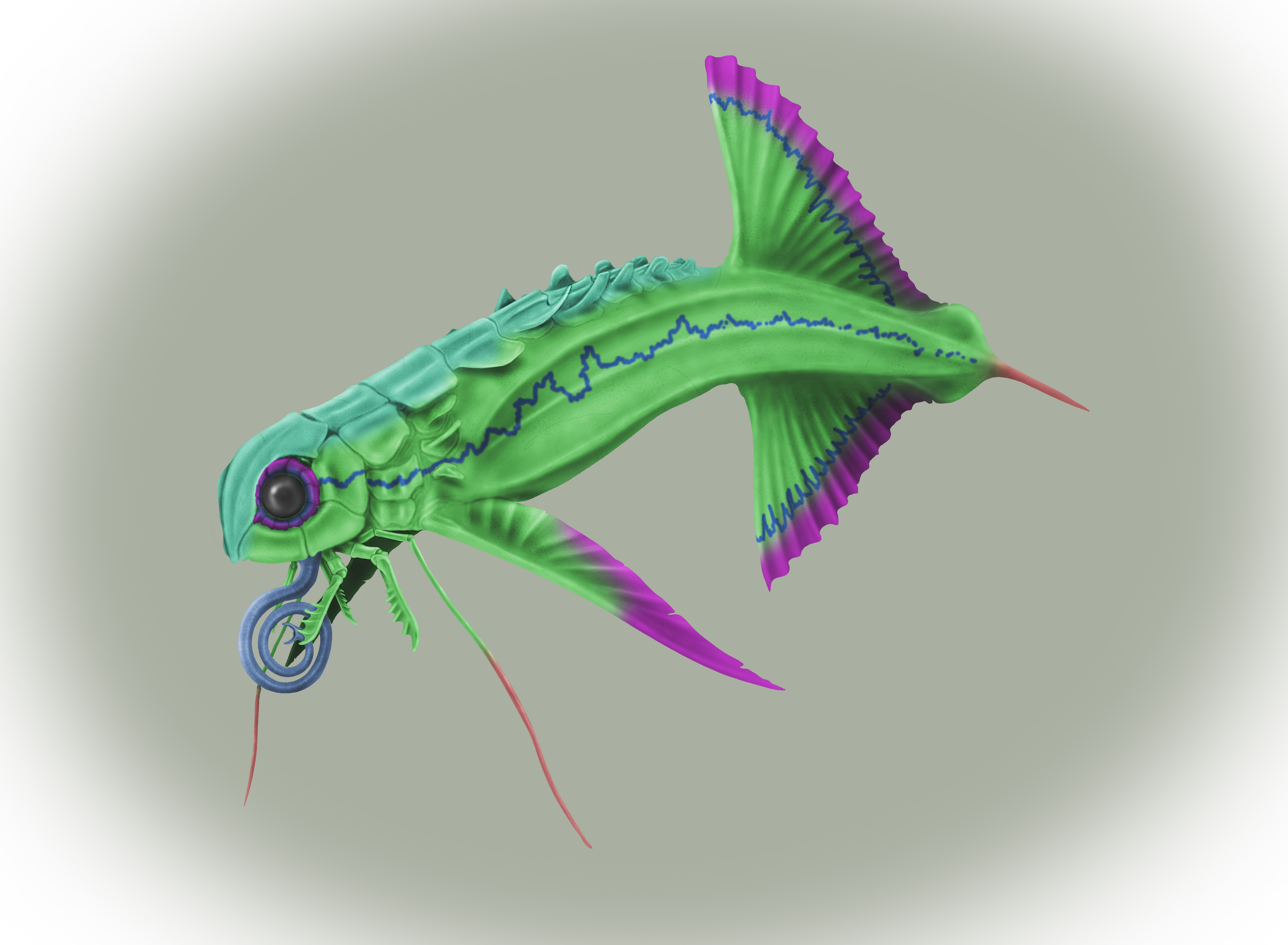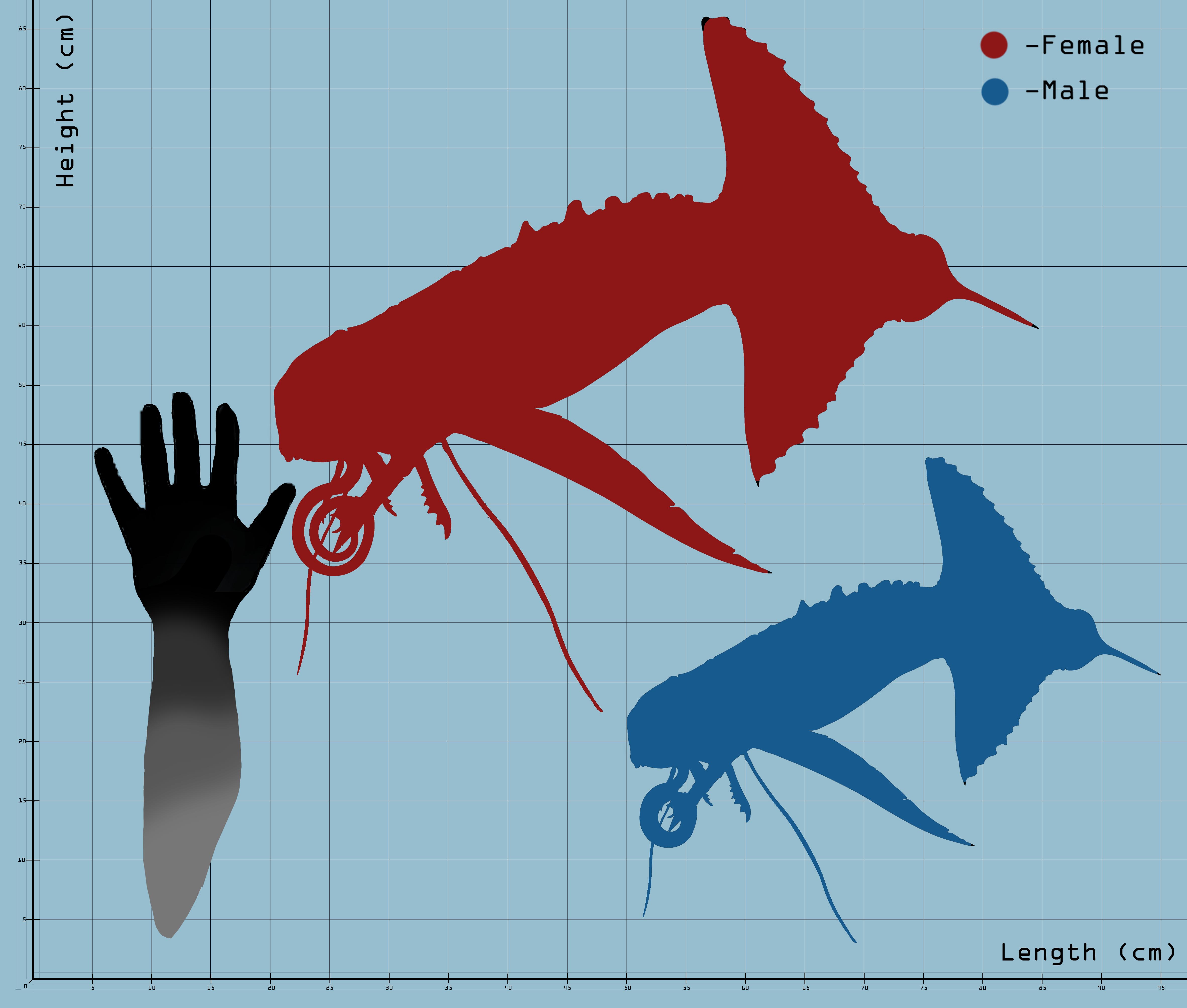Chameleon Kugawa
Protokugawa prehensilis is a Kugawinid enetodontid amphibian from the inner reefs of the Gulf Sea.
In the shallow waters in which it lives, the animal is near the top of the trophic chain, despite its reduced size; among some of its prey animals appear Herald Kikas and Red and Yellow Frisbeefish alongside many other small amphibians that find refuge in the intricate under-reef.
P. prehensilis, instead of chasing prey like its pelagic cousins, prefers to follow them slowly while they seek refuge in the under-reef and use the long and prehensile tuberculus to reach for them from their hiding spots, using the predatorial appendage to grasp prey and wrap it up in it, forcing it out of its hiding place and right to it; to navigate the under-reef without being able to physically enter it, P. prehensilis uses its keen sense of smell and hearing to pinpoint prey.
This particular genus has vestigial jaws but very developed antennae with which it can sense vibrations in the water; the reason why thee jaws have lost their functionality can be found in its hunting tactic, which doesn't include their use to keep prey from escaping.
Thanks to the high abundance of food in the reef, the animal can afford to lose many hunts without it being too taxing on the species.
The very small size made this animal particularly popular in certain circles as an "extreme" aquarium animal, equivalent to people on Earth who kept sharks in tanks in pre-Reshtu times.
Sometimes found in fish traps, the animal has a very delicate flavour and is best served alongside sweet flavoured vegetables such as King Berries and raw Traveller's corn.
Basic Information
Anatomy
- Head rounded and short, eye very wide; sclerotic plates very visible.
- Tuberculus long and thick, Jaws I & II vestigial, Jaw III very developed and thin.
- Dorsal armour progressively opens up into two distinct rows of crests along the back.
- Pectoral fin horizontal to the body, quite reduced for the family.
- Dorsal and Anal fins veiled and very high, ending at the top of the caudal ridges.
- Gill Fan short with a steep caudal drop.
- Tail continues after the end of the Gill Fan.
Genetics and Reproduction
Seasonally monogamous species.
P. prehensilis mates in the late-winter to early-spring, coinciding the hatching of the eggs with the mating season of several prey species.
Males of the species make nests in cryptic spaces among the corals, where they are protected; it decorates the nest with exoskeletons, bones and eventual shiny objects either lost in the ocean or stolen from divers, snorkelers and bathers.
The male, to attract the attention of the females, will release a strong chemical signal in the nest; females attracted to it will inspect the nest with the long tuberculus, feeling all the objects and organizing them to their liking; if the female's convinced by the location and decorations, she'll lay on the sandy bottom, signalling the male to mate.
The female will incubate the eggs for two to three weeks before laying them on the nest's ceiling, where they'll stay until the hatch; upon hatching, the young will follow the mother and father, observing and learning from them the various techniques.
Growth Rate & Stages
Ontogenesis in the species quite marked.
Young specimen are born with lighter armour and longer, almost tineless, jaws that they use to attach to the parent's tail and get dragged for the majority of their immature life.
Young specimens, small enough to fit and move in the under-reef, will hunt actively by chasing prey inside it; during this stage, the young will learn how the under-reef is composed, to be able to traverse it with only the tuberculus when they're bigger.
Loss of natal aculeus one month from birth but it usually breaks off before that while the animal is chasing prey in the under-reef.
Ecology and Habitats
Epipelagic species found at depths between 3 and 60 m.
Usually found in the inner and back reef but will also be found outside of the reef crest, on the buttress zone.
Dietary Needs and Habits
Predatorial animal hunting small sized amphibians hidings in the under-reef by using its long tuberculus to grab and forcing prey out of its hiding place.
Biological Cycle
Periannial species with few dips in activity year long.
Additional Information
Social Structure
Found living alone or in small groups of max three specimens, the animal sometimes seeks conspecifics to interact with in the form of guttural chatters and chemical language.
Domestication
Although not common, the animal is kept in home aquariums as a pigmy version of the Kugawa gigas, a symbol of strength and courage, by dedicated collectors wanting an "extreme" pet.
Due to its predatorial nature, the animal needs live food and thus many owners have to keep a breeding tank of animals such as Kikas to feed the Kugawa, making this animal's upkeep quite high.
Uses, Products & Exploitation
Of minor economic importance globally.
Consumed when found in fish traps but otherwise not sought after for food.
Perception and Sensory Capabilities
Poor eyesight (good enough to distinguish colour, shapes and objects), excellent smell and hearing.
Can feel vibrations in the water to localizes animals near it.
Symbiotic and Parasitic organisms
Afflicted by Intestinal Tube Worms and drinker worms.
Scientific Name
Enetodontia; Enetodontida; Paleostomatosoidea; Tubercolostomatosoidea; Kugawinidae ; Kugawininae; Protokugawa; P. prehensilis
Lifespan
12 Years
Conservation Status
Least Concern: no measures have been taken to protect the species.
Population Trend: STABLE
Average Weight
150-500 gr
Body Tint, Colouring and Marking
Green body with azure to sea foam upper armour.
Sclerotic plates and fin bordering deep purple to neon.
Blue band over the length of the body and along the Dorsal and Anal fins, separating the purple bordering from the green of the body.
Tuberculus cyan to deep blue.
Remove these ads. Join the Worldbuilders Guild












Comments